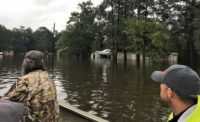Industry leaders agree that the majority of markets across the five-state region of Arkansas, Louisiana, Mississippi, Oklahoma and Texas are growing.
“There is clearly a shift emerging from retail to industrial,” says Aaron Nathan, Texas regional leader at Kimley-Horn. “While the shift from retail-driven to distribution-driven markets has been talked about for several years, we are now seeing it play out.”
Additionally, with the pace of the market, construction costs are fluctuating quickly, he says. “Fundamentals of the economy appear to be strong; there continues to be pressure on agencies to deliver infrastructure projects quickly. Because demand is outpacing the ability to keep up, that is driving prices up,” Nathan says. “Concerns are increasing about how long our markets can support the escalating costs.”
Texas in particular is seeing a project boom, as both people and companies continue to relocate to the pro-business state, notes Leslie Duke, president and general manager at Burns & McDonnell.
“You’ve got some major infrastructure projects planned, some of the biggest in the country that are planned in Texas and the region,” she says.
The Texas High Speed Rail project is one such example. AECOM is preparing an environmental impact statement for the proposed Dallas-to-Houston route, which will cost about $12 billion to build, according to project developer Texas Central Partners LLP.
Municipalities are also looking to diversify water portfolios, moving away from groundwater to surface water, which is driving business for Burns & McDonnell in the public sector, Duke says.
“Each area, even within this region, has different needs and desires regarding infrastructure improvement, and it’s our job to figure out a marriage between what those are and what we can provide,” explains Dan Williams, Garver president and CEO.
Garver’s water team is also seeing a larger demand for water reuse projects across Arkansas, Oklahoma and Texas.
Kimley-Horn’s Nathan says, “We see the market continuing strong—our only concern is that rising prices for commodities, office space and high demand for labor may make some projects less financially viable.”
ENR Texas & Louisiana Top Design Firms 2018
Regional Performance
Leading the ENR Texas & Louisiana Top Design Firms ranking for a second year in a row is Burns & McDonnell, which posted $501.85 million in regional revenue during 2017, about $6 million less than in 2016. The firm experienced solid revenue growth in every state in the region except Texas, where Burns & McDonnell saw revenue drop to $331.5 million in 2017 from $432 million in 2016.
“That goes back to the oil, gas, chemicals market. Through 2016, we had some very large projects that were remnants of a very bold market that shut down at the end of 2014,” Duke explains. “Last year was when the 2014 market caught us to some degree.”
But a resurgence in chemicals in the U.S., driven by shale oil and shale gas, is driving an abundance of chemical work in the Gulf Coast area, Duke notes.
“Overall, we continue to be beneficiaries of a strong market.”
– Aaron Nathan, Texas Regional Leader, Kimley-Horn
Power utilities American Electric Power (AEP) and Entergy are investing in infrastructure and transmission assets across the region. Burns & McDonnell is working with both utilities and putting down roots in New Orleans to support the ongoing Entergy program.
“I think our biggest news of this year is we acquired a firm called Ref-chem, [an oil services contractor] that is headquartered in Odessa but has their largest workforce here in Houston,” Duke says.
Kimley-Horn, last year’s ENR Texas & Louisiana Design Firm of the Year, posted about a $20-million gain in regional revenue to reach $164 million in 2017.
“Corporate relocations continue to drive a lot of momentum in the Dallas-Fort Worth area,” Nathan says. “Austin is continuing to grow due to its popularity as a place to live, and Houston is coming out of a local recession driven by low oil prices. Overall, we continue to be beneficiaries of a strong market.”
The firm is helping VIA Metropolitan Transit, San Antonio’s transit agency, plan for future improvements in bus rapid transit and is also developing a transportation management plan for the Texas Dept. of Transportation for upcoming construction on I-35.
One of the firms that experienced a revenue decline from 2016 was Stantec, which reported regional revenue of $181 million in 2017, down about $30 million.
“Our revenue was stronger in 2016 due to the completion of large Hurricane Katrina-related projects, including start-up of the largest pump station in the United States to protect New Orleans from future flood events and the design completion of two large highway projects in Texas,” explains David Irvine, senior vice president and regional leader at Stantec.
“Our core business is now stronger and has increased in size significantly,” he says.
Arkansas-based Garver’s revenue increased by $24 million from 2016, up to $88 million in 2017, thanks in part to the firm’s continued investment in program management and water reuse projects.
“A continuation of organic growth that led to new relationships while pursuing exciting projects with long-serving clients led to one of our most successful years,” Williams says.
Rapid expansion into the Texas market, with new offices in San Antonio, Harlingen and Athens, is helping Garver pursue aviation, construction, transportation and water projects across the state.
Major projects for the firm include the Gilcrease Expressway, a long-needed completion to an interstate loop on the southwestern corner of Tulsa, and the Connecting Arkansas Program, a 10-year program to deliver 36 highway improvement projects across the state.
Garver is also providing program management and preliminary design for a 70-mile pipeline, a treatment plant and associated infrastructure for the Kaw Lake Water Supply Program in Enid, Okla.
While AECOM had regional revenue of nearly $335 million in 2017, about $100 million less than in 2016, the firm grew its backlog and the number of new hires as a result of winning key contracts for some major water, transportation, program management and environmental projects across the region.
AECOM is managing school improvements for Austin Independent School District under an $800-million 2017 bond program. It was the largest program passed in the district’s history and the largest K-12 bond approved in Texas in 2017, says Travis Boone, executive vice president and Gulf-Southwest region executive at AECOM.
Alternative Project Delivery
The downturn over the last several years has had varying effects on clients, notes Duke. Some reduced their internal workforce, making them more dependent on outsourced consultants, while others shored up their internal capabilities and improved project execution, she says.
Today, clients appear to be going back to the outsourced EPC model, Duke adds.
“But during the last three years, we did see a little bit more internal self-performance. The difference in this turn-up is it’s a little more gradual than we’ve seen in the past,” she says.
The firm’s energy and power sector clients, for example, are looking more favorably on EPC delivery, Duke says. “That’s a growing part of their delivery repertoire and creating a lot of opportunity for us,” she says.
On the other hand, Stantec is seeing growth in alternative project delivery (APD) and public-private partnerships (P3s) across most of its sectors, Irvine notes.
“With limited funding, but large needs, clients are becoming creative in finding funding through these delivery methods,” he says.
Boone notes the increased interest in ADP and P3s in both the private sector and government. He says that Louisiana is now moving forward with at least three design-build transportation opportunities that have been shelved for the last couple of years, and even though tolling restrictions in Texas have constrained some P3 opportunities, “we anticipate an increase in the number of design-build opportunities for capital improvement projects throughout Texas,” he says.
But it’s not just funding that’s driving APDs. Clients are also looking for turnkey solutions that offer a one-stop approach to meet their needs, Boone says.
“APDs such as design-build, design-build-finance or design-build finance and operate allow our clients to simplify and coordinate their development and construction needs and maintain a lean organizational structure by outsourcing capital improvement efforts,” he says. “Clients across business lines are seeking more creative financing opportunities for funding major capital improvements.”
Recovery, Resilience Ahead
The Trump administration’s proposed infrastructure plan that would turn $200 billion in federal money into $1.5 trillion to fix America’s infrastructure was announced back in February. “But the majority of the funding is expected to come from state and local governments,” Boone says. “At this time, it’s impossible to predict if or when the federal government will take action on infrastructure spending.”
In the meantime, what is certain is the recovery and resiliency work that lies ahead across the Texas and Louisiana coasts, as states continue to recover from major storms such as Hurricane Harvey.
More than $1 billion in federal funding for infrastructure projects is expected to reach the Houston area later this year or early next year to begin a five- to 10-year program of recovery and resilience work.
Coastal restoration continues in Louisiana as well. Two controlled-sediment diversions, Mid-Barataria and Mid-Breton, are being built under the $2.4-billion Mississippi River Mid-Basins Sediment Diversions Program. Mid-Barataria construction is underway.
“Some states in our region are ahead of the curve when it comes to enacting their State Action Plans to receive Restore Act funding,” adds Boone. “Louisiana and Mississippi have SAPs that address the Restore Action spending and are receiving millions to address coastal restoration. However, Texas state agencies should collaborate to develop a single comprehensive SAP prior to requesting Restore Act funds.”
Federal work has picked up, thanks to the FY18 Emergency Supplemental Bill that provides $17.4 billion to the U.S. Army Corps of Engineers to help reduce the risk of future damage from floods and storms, and the FY18 Omnibus Bill that provides for increased budgets and spending for all agencies, Boone says.
“We have already experienced an increase in IDIQ RFPs to provide agencies the capacity needed to execute the increase in budget authority,” he says.
Meanwhile, the deferred investments in infrastructure projects that happened during the 2008 downturn are now beginning to move forward, Irvine notes.
“I remember when there was talk of a stimulus package in 2009, clients put the brakes on their projects waiting for federal money to come in. With talk of a stimulus package this time, we haven’t really seen the same reaction,” Williams adds. “There’s certainly anticipation for how a new stimulus package will work—particularly in the rural parts of this region. Private money for infrastructure projects in less densely populated areas is something that could be a challenge.”








Post a comment to this article
Report Abusive Comment